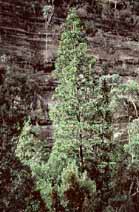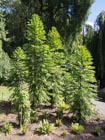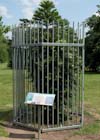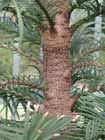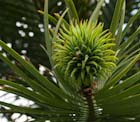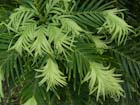Wollemia nobilis
W.G.Jones, K.D.Hill & J.M.Allen 1995
Common names
Wollemi pine.
Taxonomic notes
Wollemia is a monotypic genus. It was discovered—and in this case, probably a new discovery, i.e. not just previously unknown to Botany—in August, 1994. Of the other extant Araucariaceae, the new genus appears closest to Agathis, but it has many features in common with Cretaceous and early Tertiary fossil groups such as Araucarioides, and may be closer to these. Pollen also more closely resembles fossil pollen examples than pollen of either Agathis or Araucaria (Royal Botanic Gardens Sydney 1999).
The chloroplast genome has been sequenced, and reveals exceptionally low genetic diversity (Yap et al. 2015, Greenfield et al. 2016). Population genetic studies are ongoing, and preliminary investigations have identified low levels of variation both within and between subpopulations (Mackenzie et al. 2021). Analysis of chloroplast DNA (the rbcL gene) from Wollemia along with 5 species of Araucaria and 4 species of Agathis indicate that Araucariaceae, Agathis and Araucaria are all monophyletic, with Wollemia the sister group to Agathis (Gilmore and Hill 1997).
Description
Monoecious evergreen trees to 40 m tall and 120 cm dbh, often coppicing from base, with a slender columnar crown. Bark first red-brown, scaly, peeling; later covered in spongy dark tubercles up to 1 cm diameter. Terminal shoots clad in helically arranged decurrent narrowly triangular leaves 3-10 × 2-4 mm; other twigs horizontal, leaves opposite or subopposite, twisted so that adaxial surfaces are uppermost, linear to narrow-triangular, hypostomatic, dark green above, more pale beneath, apex obtuse or rounded. The leaves on the youngest shoots are short scale leaves to 3 mm long, but as twigs thicken in later years, the leaves increase up to 8 cm long and 5 mm wide. Pollen cones terminal on lateral shoots, up to 110 × 19 mm, subtended by ca. 8 helically arranged broad bracts 3-5 mm long and wide. Seed cones also terminal on lateral shoots, usually borne in upper crown above the pollen cones, (sub)globular, green becoming brown and shedding bract-scales at maturity, up to 12.5 cm long. Bract-scales flattened, 12-17 × 14-22 mm, 3-5 mm thick, with a narrow-triangular apex 6-12 mm long and 2-4 mm wide at base. Seed scales wholly fused with and indistinguishable from bracts. Seeds with a circumferential wing, 6-9 mm across including wing. Epigeal germination with 2 cotyledons (Farjon 2010).
Distribution and Ecology
Australia: New South Wales: known only from a very wet and sheltered gorge in the Wollemi National Park, in a rugged mountainous area of the Blue Mountains (Royal Botanic Gardens Sydney 1999). See Araucariaceae for a map showing approximate location. Shortly after discovery, the wild population consisted of about 40 adult plants and about 200 seedlings (New South Wales National Parks and Wildlife Service 1998); a 2020 census revealed a total of only 89 individuals, 46 of which are mature, and determined that plants often fail to successfully transition from juvenile to mature status (Mackenzie et al. 2021). The species has been widely planted in arboreta and has become a popular ornamental among conifer fans, and seeds are periodically available from various sources in Australia, North America, and western Europe. Conversely, the species is threatened onsite by two related species of Phytophthora, P. cinnamomi and P. multivora, that are highly pathogenic and were likely introduced by unauthorized visitors to the site (Phytophthora spores can easily be transported in soil residues on the soles of shoes, and authorized visitors have long been required to observe sterilization procedures) (Salleh 2005, Puno et al. 2015). Two species of Botryosphaeria, a native, stem-infecting fungal pathogen, have also been identified (Slippers et al., 2005).
Associated tree species at all sites in habitat include Ceratopetalum apetalum, Doryphora
sassafras and Acmena smithii, while numerous fern and vine species dominate the forest floor (Benson and Allen 2007).
The only known grove of this species (and after decades of searching for another, it seems to be the only grove) was nearly destroyed in Australia's catastrophic 2019-2020 fire season. Only a desperate effort by firefighters saved this grove, leaving it the sole green patch in a devastated landscape; photos and reporting are provided by Peter Hannam (2020). The firefighters were careful to take measures to avoid phytophthora contamination.
The IUCN reports that this species is facing an extremely high risk of extinction in the wild because the population consists of fewer than 50 mature individuals. Mackenzie et al. (2021) provide a review of the species' ecology, as well as detailed account of both in situ and ex situ conservation and management efforts.
Remarkable Specimens
No data as of 2023.02.22.
Ethnobotany
No use known before the tree's discovery. Soon after discovery, it was regarded as being at great risk from unauthorized collection and the Australian government instituted a program to establish an ample stock of nursery plants to serve the desires of collectors and botanical gardens. Since then, it has fully entered the horticultural trade. Specimens are now widely available, and it has been found hardy to Zone 7 in the U.S. Some trees have even grown large enough to be harvested for a rare and costly craft wood; photo at right.
Observations
Because the native stock is extremely small, it could easily by wiped out by collectors. Thus, its location is being kept secret. Efforts to reproduce the plant have been successful and seeds are now generally available. It is also widely available to view in botanical gardens and arboreta, so that the stock of such plants probably exceeds the population of plants in habitat.
Remarks
Woodford (2000) provides a very readable account of the discovery of this species by a group of recreational canyoneers, and its subsequent documentation and protection by concerned scientists.
Australia's Royal Botanical Garden is very proud of Australia's newly-discovered conifer; it has its own home page (Royal Botanic Gardens Sydney 1999), featuring descriptions and images.
This species is currently listed on the index of threatened Australian plant species.
"Adult and juvenile shoots of Wollemia differ in leaf arrangement, leaf shape, and cuticular features: in these features they are most similar to Araucaria. The cone scales have a long, distal spine reminiscent of Araucaria section Eutacta, but the winged seeds that are ontogenetically free from, and shed independently from, the cone scale are similar to Agathis. Shoots with variable leaf types, Araucaria-like cone scales, and Agathis- like winged seeds are found in several plant fossil assemblages from the Cretaceous of Australia; these fossil conifers, which had been recognized as araucarian, can now be favorably compared with Wollemia. Pollen of Wollemia is indistinguishable from the fossil pollen form-genus Dilwynites, which has a fossil record extending back to the Late Cretaceous in Australia and New Zealand. Reexamination of Mesozoic and Tertiary paleofloras will most probably reveal an important contribution of Wollemia to the fossil record of Araucariaceae" (Chambers et al. 1998).
Branch abscision is a peculiar feature of a number of species in the Araucariaceae and seems to be an adaptation, like flaking bark, that reduces epiphyte loads. Wollemia, however, is unique in producing only first-order branches and subsequently abscising them. The anatomy of this curious phenomenon is described by Burrows et al. (2007), who note that this property may have contributed to the species' decline since the Tertiary: it certainly doesn't appear to enhance its ability to compete with other trees.
Citations
Benson, John and Chris Allen. 2007. Vegetation associated with Wollemia nobilis (Araucariaceae). Cunninghamia 10(2):255-261.
Burrows, G. E., P. F. Meagher, and R. D. Heady. 2007. An anatomical assessment of branch abscission and branch-base hydraulic architecture in the endangered Wollemia nobilis. Annals of Botany 99(4):609–623, https://doi.org/10.1093/aob/mcm003.
Greenfield, A., H. McPherson, T. D. Auld, S. Delaney, C. A. Offord, M. Van Der Merwe, J. Y. S. Yap, and M. Rossetto. 2016. Whole-chloroplast analysis as an approach for fine-tuning the preservation of a highly charismatic but critically endangered species, Wollemia nobilis (Araucariaceae). Australian Journal of Botany 64:654–658. doi:10.1071/BT16105.
Hannam, Peter. 2020.01.15. Incredible, secret firefighting mission saves famous 'dinosaur trees'. Sydney Morning Herald, accessed 2020.01.15.
Jones, W. G., K. D. Hill and J. M. Allen. 1995. Wollemia nobilis, a new living Australian genus and species in the Araucariaceae. Telopea 6: 173-176).
Mackenzie, B., S. Clarke, H. Zimmer, E. Liew, M. Phelan, C. Offord, L. Menke, D. Crust, J. Bragg, H. McPherson, M. Rossetto, D. Coote, J. Yap, and T. Auld. 2021. Ecology and conservation of a living fossil: Australia's Wollemi pine (Wollemia nobilis). EcoEvoRxiv. October 22. doi:10.32942/osf.io/3sjwx.
Puno, V. I., M. H. Laurence, D. I. Guest and E. C. Y. Liew. 2015. Detection of Phytophthora multivora in the Wollemi Pine site and pathogenicity to Wollemia nobilis. Australian Plant Pathology, DOI 10.1007/s13313-014-0344-1.
Royal Botanic Gardens Sydney. 1999. Wollemi. http://www.rbgsyd.nsw.gov.au/html/Wollemi.html, accessed 2001.07.19, now defunct.
Salleh, Anna. 2005. Wollemi pine infected by fungus. ABC Science Online. http://www.abc.net.au/science/news/stories/s1497961.htm, accessed 2007.01.06.
Slippers, B., B. A. Summerell, P. W. Crous, T. A. Coutinho, B. D. Wingfield, and M. J. Wingfield. 2005. Preliminary studies on Botryosphaeria species from southern hemisphere conifers in Australasia and South Africa. Australasian Plant Pathology 34:213–220. doi:10.1071/AP05020.
Woodford, James. 2000. The Wollemi Pine: The Incredible Discovery of a Living Fossil From the Age of the Dinosaurs. Australia. Text Publishing.
Yap, J. Y. S., T. Rohner, A. Greenfield, M. Van Der Merwe, H. McPherson, W. Glenn, G. Kornfeld, E. Marendy, A. Y. H. Pan, A. Wilton, M. R. Wilkins, M. Rossetto, and S. K. Delaney. 2015. Complete chloroplast genome of the Wollemi pine (Wollemia nobilis): Structure and evolution. PLoS ONE 10:1–15. doi:10.1371/journal.pone.0128126.
See also
The species account at Threatened Conifers of the World.
wollemipine.com provides a variety of information (2006.08.10).
Chambers, T. C., A. N. Drinnan, and S. McLoughlin. 1998. Some morphological features of Wollemi pine (Wollemia nobilis: Araucariaceae) and their comparison to Cretaceous plant fossils. Int. J. Plant Sci. 159: 160-171.
Dettmann, M. E. and D. M. Jarzen. 2000. Pollen of extant Wollemia (Wollemi pine) and comparisons with pollen of other extant and fossil Araucariaceae. P. 187-203 in Pollen and Spores Morphology and Biology (M.M. Harley, C.M. Morton and S. Blackmore, eds.). R. Bot. Gard. Kew.
Greenaway, C. 1995. Jurassic pines in Wollemi Park. Wildlife Australia 32(1):3.
Hill, Ken D. 1997. The Wollemi Pine: A recently discovered Australian genus of Araucariaceae. American Journal of Botany 84(6) SUPPL., pp. 202-203.
Jones, W. 1995. Wollemi Pine - the missing link? [rediscovery of population of 23 adults and 16 juveniles in Wollemi National Park, N.S.W.]. On the Brink 6: 2.
Macphail, M., K. Hill, A. Partridge, E. Truswell and C. Foster. 1995. Australia: Wollemi pine: old pollen records for a newly discovered genus of gymnosperm. Geol. Today March-April: 42-44.
New South Wales National Parks and Wildlife Service. 1998. Wollemi Pine (Wollemia nobilis) recovery plan. Hurstville, NSW: New South Wales National Parks and Wildlife Service. 69p.
Offord, C. 1996. Conserving the Wollemi Pine: an integrated approach. [Recovery Plan being prepared by ANCA. 'The simple act of visiting the site poses one of the greatest threats...' Danthonia 5(2) : 12-14.
Payne, Christine. 1998. The Wollemi pine - a portrait. http://www.axon.com.au/mindsight/Wollemi/index.htm (accessed 19-Jul-2001).
Woodford, James. 1995. Intruders damage Wollemi pines. The Age 24-02-1995: 5.


